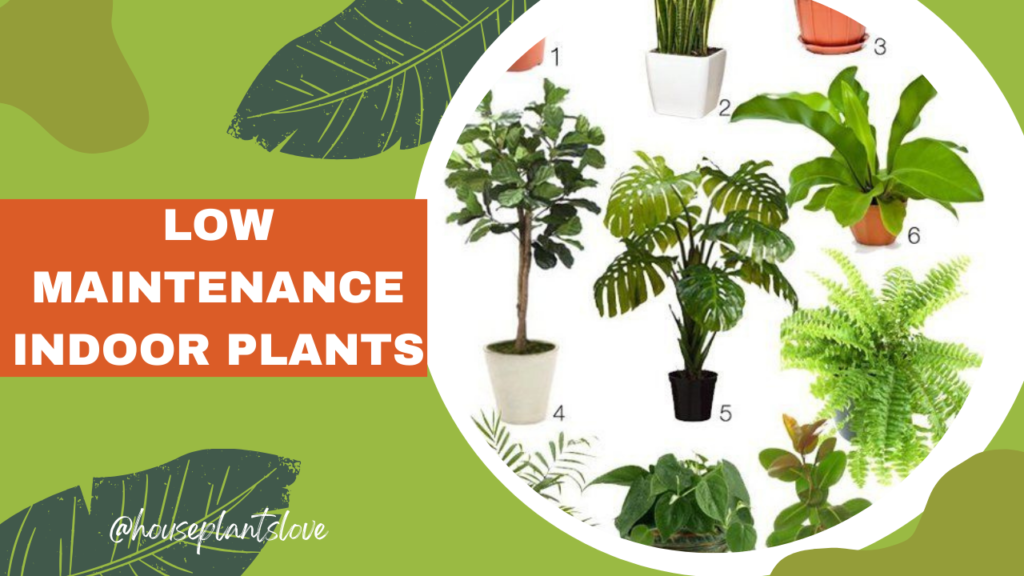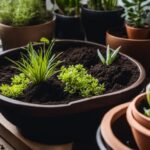Best top 10 low maintenance indoor plants, 10 house plants that love to be ignored for apartment & house
Having Low Maintenance indoor plants in your home or office is not just nice to look at; it’s also good for you. They make the air better, help you feel less stressed, and make your space look better. But not everyone is great at taking care of plants or has a lot of time to spend on them. That’s where low maintenance indoor house plants come in. These plants are tough and don’t need much attention. In the previous article, we talked about the Top 10 Indoor House Plants for Positive Energy, and in this article, we’ll tell you about the top indoor plants that are easy to care for, even if you’re really busy. If you’re looking for low maintenance indoor house plants that are easy to keep alive.
Taking care of houseplants can sometimes feel overwhelming, especially for those of us with busy lives. But fear not! I’ve compiled a list of the top 15 low maintenance houseplants that will bring all the beauty without the hassle. These easy care indoor plants are perfect for beginners or those who simply want a green touch in their home without the need for constant attention. From hardy houseplants that can withstand neglect to drought-tolerant varieties that thrive on minimal water, there’s something for everyone on this list.

Top 10 House plants that need Low Maintenance for apartment & house
1. Snake plant
The snake plant, also known as the mother-in-law’s tongue, is one of the most popular low-maintenance indoor plants for a reason. It’s incredibly tolerant of neglect, can thrive in low light, and only needs to be watered sparingly. It has tall, upright leaves with interesting patterns, which make them a good fit for all kinds of homes. Snake plants are also very good air-purifying plants, making them a great choice for any room in your home.
2. ZZ plant
The ZZ plant, also known as the Zanzibar gem, is another low-maintenance indoor plant that’s known for being easy to care for. ZZ plants are famous for being super tough and easy to handle. They have shiny, dark green leaves that look like feathers and make any room look fancy. ZZ plants are fine with not much light and you don’t need to water them a lot. Actually, giving them too much water is a mistake many people make, so it’s best to let the soil dry out before watering again. ZZ plants are also slow-growing, so you don’t have to worry about repotting them very often.
3. Pothos
Pothos, also called devil’s ivy, is a tough hanging plant that’s great for people new to plant care. Pothos is a versatile and easy-to-care-for indoor plant that can be grown in a variety of conditions. It’s tolerant of low light, but it will grow faster and fuller in bright, indirect light. Pothos is also a very forgiving plant. Its leaves look like hearts and come in different colors, from plain green to mixed shades. They’re also famous for cleaning the air by getting rid of bad stuff like formaldehyde and xylene.
4. Spider plant
Spider plants are another popular low-maintenance indoor plant. They feature arching green and white striped leaves that cascade elegantly from the pot. These hardy plants can adapt to various light conditions and only need regular watering. They’re known for their air-purifying properties and their ability to produce baby plantlets, which can be easily propagated to start new plants. Spider plants are also very easy to care for and can tolerate a variety of conditions.
5. Peace lily
Peace lilies are beautiful flowering indoor plants that are relatively low-maintenance. They prefer bright, indirect light, but they can also tolerate low light conditions. Peace lilies need to be watered regularly, but be careful not to overwater them, as this can lead to root rot. Peace lilies are not only beautiful but also known for their air-purifying properties. They produce striking white flowers amid dark green foliage, creating a serene atmosphere in your home. Peace lilies prefer moderate, indirect light and should be watered when the top inch of soil feels dry. They’re forgiving plants and will drop slightly when they need water, serving as a clear indicator of when it’s time to hydrate them.
6. Jade plant
The jade plant is a succulent that’s known for its thick, fleshy leaves. It’s a very low-maintenance plant that can thrive in low light conditions. Jade plants only need to be watered when the soil is completely dry.
7. Aloe vera
Aloe vera is another succulent that’s known for its low-maintenance care requirements. It’s also a very beneficial plant, as the gel from its leaves can be used to treat a variety of skin conditions. Aloe vera plants prefer bright, indirect light, but they can also tolerate low light conditions.
8. Rubber plant
Rubber plants are known for their bold, dark green leaves and their ability to tolerate neglect. It is large and elegant for any room. It’s relatively low-maintenance, but it does prefer bright, indirect light and regular watering. Rubber plants can also be grown in low light conditions, but they may not grow as quickly.
9. Monstera
The monstera, also known as the Swiss cheese plant, is a popular indoor plant that’s known for its large, perforated leaves. It’s a relatively low-maintenance plant, but it does prefer bright, indirect light and regular watering. Monsteras can also be grown in low light conditions, but they may not grow as quickly.
10. Chinese money plant
The Chinese money plant is a trailing plant that’s known for its round, coin-shaped leaves. It’s a very low-maintenance plant that can thrive in a variety of conditions. Chinese money plants prefer bright, indirect light, but they can also tolerate low light conditions.
11. Boston Fern – A Hardy and Humidity-Loving Plant
The Boston Fern, with its lush and feathery foliage, is a classic houseplant that adds a touch of elegance to any indoor space. Despite its delicate appearance, this low maintenance fern is surprisingly hardy and can thrive in low light conditions, making it suitable for various rooms in your home.
One of the standout features of the Boston Fern is its preference for high humidity. It loves the moisture-rich environment, which makes it an excellent choice for bathrooms or kitchens where humidity levels are higher. If you live in a drier climate, you can easily create a humid microclimate for your Boston Fern by placing a tray filled with water nearby or using a humidifier.
To ensure that your Boston Fern stays fresh and vibrant, it’s important to provide it with regular misting. Mist the foliage with room temperature water between waterings to maintain the desired humidity levels. This simple step helps prevent the fronds from drying out and looking dull, keeping your fern looking its best.
Tips for Caring for Your Boston Fern:
- Place your Boston Fern in a location with indirect light, away from direct sunlight.
- Keep the soil consistently moist but not waterlogged. Water whenever the top inch of soil feels dry to the touch.
- During the growing season, apply a balanced liquid fertilizer once a month to promote healthy growth.
- Regularly remove any dead or yellowing fronds to maintain a tidy appearance.
The Boston Fern is not only a beautiful addition to your indoor plant collection but also a low maintenance fern that can thrive in various environmental conditions. Its hardiness, humidity-loving nature, and lush foliage make it a popular choice for both beginners and experienced plant lovers.
| Plant Care Requirements | Boston Fern |
|---|---|
| Light | Indirect light, away from direct sunlight |
| Watering | Consistently moist soil, watering when the top inch feels dry |
| Humidity | High humidity, misting between waterings |
| Temperature | Average room temperature, avoiding extreme fluctuations |
| Fertilizer | Monthly application of balanced liquid fertilizer during the growing season |
| Pruning | Regular removal of dead or yellowing fronds |
Money Tree – A Symbol of Good Luck with Easy Care
The Money Tree is not only believed to good luck plant and prosperity, but it is also an easy-care indoor tree. It thrives in bright, indirect light and can tolerate overwatering, making it a resilient choice for those who tend to forget to water their plants. With a simple watering routine and occasional rotation to ensure even growth, this low maintenance tree can bring beauty and good fortune to any space.
Benefits of the Money Tree:
- Brings good luck and prosperity
- Thrives in bright, indirect light
- Tolerates overwatering
- Requires minimal care and maintenance
- Easy to grow and care for
| Light Requirements | Watering | Maintenance | Size |
|---|---|---|---|
| Bright, indirect light | Water when the top inch of soil is dry | Rotate occasionally for even growth | Can reach heights of up to 6 feet |
String of Pearls – An Elegant and Fast-Growing Succulent
The String of Pearls is a stunning succulent that adds a touch of elegance to any space. With its delicate trailing vines resembling a beautiful string of pearls, this plant is sure to captivate anyone who lays eyes on it. Whether cascading from a hanging pot or trailing over the edge of a shelf, the String of Pearls creates a unique and enchanting display.
Not only is the String of Pearls visually appealing, but it is also a fast-growing plant, adding to its allure. With the right conditions, including bright, indirect light, this succulent will thrive and flourish. Its minimal water requirements make it a low maintenance choice, with the top few inches of soil needing to be dry before watering again.
Bringing the beauty of nature indoors has never been easier than with low maintenance succulents like the String of Pearls. Its graceful trailing vines and fast-growing nature make it a perfect addition to any home or office. Whether you’re a seasoned plant lover or a beginner looking for an easy-care houseplant, the String of Pearls is sure to delight and impress with its unique charm and effortless beauty.
Caring for your low-maintenance Indoor plants
Even though these plants are low-maintenance, they still require some basic care. Here are a few tips:
- Water regularly, but don’t overwater. Most low-maintenance indoor plants only need to be watered once a week, or even less often in the winter. Be careful not to overwater, as this can lead to root rot. You can also read a guide about watering plants.
- Fertilize regularly, but don’t overfertilize. Most low-maintenance indoor plants only need to be fertilized once a month during the growing season. Be careful not to overfertilize, as this can damage the plant.
- Provide bright, indirect light. Most low-maintenance indoor plants prefer bright, indirect light. However, some plants, such as snake plants and ZZ plants, can tolerate low light conditions.
- Maintain a comfortable temperature. Most low-maintenance indoor plants prefer temperatures between 65 and 75 degrees Fahrenheit. However, some plants, such as succulents Plants, can tolerate warmer temperatures.
- Repot as needed. Most low-maintenance indoor plants only need to be repotted once every year or two. Repot in the spring, when the plant is actively growing.
Additional tips for caring for your low-maintenance indoor plants
- Check your plants regularly for pests and diseases. Early detection and treatment are key to keeping your plants healthy.
- Remove dead or dying leaves and stems. This will help to prevent the spread of disease.
- Clean the leaves of your plants regularly. This will help to remove dust and dirt, which can block sunlight and prevent the plant from photosynthesizing.
- Mist your plants regularly, especially if you live in a dry climate. Misting can help to increase the humidity around your plants, which can be beneficial for their health.
- Rotate your plants regularly. This will help to ensure that all sides of the plant receive equal amounts of light.
Troubleshooting common problems with low-maintenance indoor plants
- Brown leaves: Brown leaves can be caused by a variety of factors, such as overwatering, underwatering, too much direct sunlight, or pests and diseases. If you notice brown leaves on your plant, try to identify the cause and take corrective action.
- Yellow leaves: Yellow leaves can be caused by a variety of factors, such as nutrient deficiency, overwatering, or pests and diseases. If you notice yellow leaves on your plant, try to identify the cause and take corrective action.
- Drooping leaves: Drooping leaves can be caused by a variety of factors, such as underwatering, overwatering, or too much direct sunlight. If you notice drooping leaves on your plant, try to identify the cause and take corrective action.
- Pests and diseases: Low-maintenance indoor plants are less susceptible to pests and diseases than other plants, but they can still be affected. If you notice any pests or diseases on your plant, isolate the plant from other plants and treat the problem immediately.
With a little care and attention, your low-maintenance indoor plants will thrive for many years to come.
What are low maintenance houseplants?
Low maintenance houseplants are varieties of plants that require minimal care and attention, making them perfect for beginners or those with busy schedules.
What should I consider when choosing low maintenance houseplants?
When choosing low maintenance houseplants, consider factors such as drought-tolerance, light requirements, pet-friendliness, and the level of care you are able to provide.
Are low maintenance houseplants suitable for beginners?
Yes, low maintenance houseplants are perfect for beginners as they require minimal care and attention, making it easier to keep them alive and thriving.
Can low maintenance houseplants survive in low light conditions?
Yes, some low maintenance houseplants, such as the Boston Fern, can thrive in low light conditions. However, it’s essential to choose the right plant for the specific lighting conditions of your home.
How often should I water low maintenance houseplants?
The watering frequency for low maintenance houseplants varies depending on the specific plant and its water requirements. It’s best to check the soil moisture before watering to prevent overwatering or underwatering.
Do low maintenance houseplants require regular pruning?
Most low maintenance houseplants do not require regular pruning. However, occasional pruning may be necessary to remove dead or yellow leaves and promote healthy growth.
Can low maintenance houseplants be placed in bathrooms or kitchens?
Yes, some low maintenance houseplants, like the Boston Fern, prefer high humidity, making them well-suited for bathrooms or kitchens. However, it’s important to ensure proper lighting conditions and avoid placing plants in areas prone to temperature fluctuations.
Are low maintenance houseplants safe for pets?
Many low maintenance houseplants are safe for pets. However, it’s important to research and choose pet-friendly plants to avoid any potential toxicity issues.
What are some low maintenance succulents?
Some low maintenance succulents include the Cuddly Cactus, Kalanchoe Flapjack, and String of Pearls. These plants have minimal watering requirements and are well-suited for those with busy schedules.




